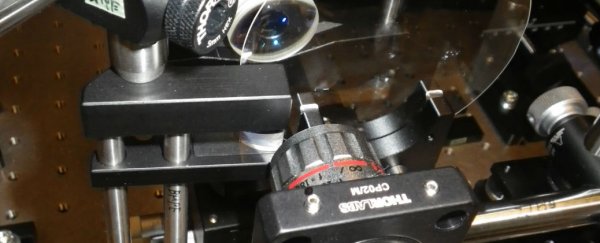Japanese radiologists have created a new super-fast camera that can capture events occurring at one-sixth the speed of light, or roughly 45,000 kilometres per second. Allowing scientists to record more frames per second back-to-back than any other technology, the device will be used to capture the body's physical and biological processes in far more detail than ever before.
Called STAMP, the camera can record events at a speed of more than 1-trillion-frames-per-second, which is more than 1,000 times faster than a conventional high-speed camera. "[It] holds great promise for studying a diverse range of previously unexplored complex ultrafast phenomena," one of the team, radiologist Keiichi Nakagawa from the University of Tokyo, said in a press release.
The technology works by splitting a single light pulse into a fast barrage of rainbow-coloured smaller pulses. This process is called dispersion, and it's what we see when we observe rainbows in the sky. According to the press release, "Each separate colour flash can then be analysed to string together a moving picture of what the object looked like over the time it took the dispersed light pulse to travel through the device."
"Conventional high-speed cameras are limited by the processing speed of their mechanical and electrical components," the researchers explain. "STAMP overcomes these limitations by using only fast, optical components."
While another imaging technique, known as the pump-probe method, can capture frames faster than STAMP, it can only capture one frame at a time. This means the event you want to capture would need to occur again and again so you could record it at every frame. Not only is it painstaking work, but it can only examine processes that can be reproduced. "Many physical and biological phenomena are difficult to reproduce," said Nakagawa. "This inspired me to work on an ultrafast camera that could take multiple frames in a single shot."
The idea came from Nakagawa's previous work on how acoustic shock waves changed biological cells – he thought loud sounds could have the potential to spur bone and blood vessel growth. "Since there was no suitable technique, I decided to develop a new high-speed imaging technique in my doctoral program," Nakagawa said.
The team is working to increase how many frames the camera can take in a single shot: last August it was six, and they're now working towards 25. Eventually, they hope to reach 100 frames per shot.
Nakagawa says the camera has enormous potential, including, "the laser ignition of fusion, the phase transition of materials," and how electromagnetic fields cause solid material to explode into atomic particles. "There might be many potential applications of STAMP that I have not imagined," Nakagawa said, and is eager to get other researchers on board.
